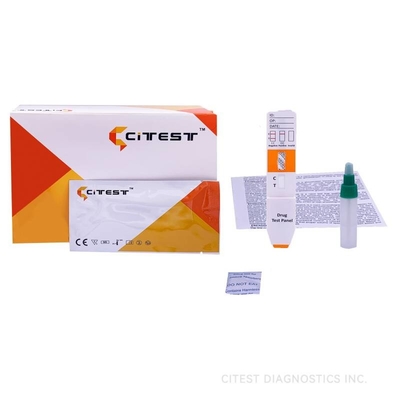

A rapid test for the qualitative detection of 5000 ng/mL Acetam/inophen (ACE) in human urine.
| Product features | Parameters |
| Principle | Chromatographic Immunoassay |
| Format | Dipstick, Cassette, Panel, Cup |
| Specimen | Urine, Powder |
| Certificate | CE |
| Reading Time | 5 minutes |
| Pack | 25T/40T/50T |
| Storage Temperature | 2-30°C |
| Shelf Life | 2 Years |
| Sensitivity | 93.50% |
| Specificity | 98.60% |
| Accuracy | 97.00% |
| Cut-Off | 5000 ng/mL* |
For medical and other professional in vitro diagnostic use only.
Application:
The ACE Rapid Test (Urine) is a rapid chromatographic immunoassay for the detection of Aceta/minophen in human urine at a cut-off concentration of 5,000ng/mL.
This assay provides only a qualitative, preliminary analytical test result. A more specific alternate chemical method must be used in order to obtain a confirmed analytical result. Gas chromatography/mass spectrometry (GC/MS) or Liquid Chromatography/mass spectrometry (LC/MS) are the preferred confirmatory methods. Clinical consideration and professional judgment should be applied to any drug of abuse test result, particularly when preliminary positive results are used.
Description:
Acetami/nophen is one of the most commonly used drugs, yet it is also an important cause of serious liver injury. Acetam/inophen is the generic name of a drug found in many common brand name over-the-counter (OTC) products, such as Tylenol, and Prescription (Rx) products, such as Vicodin and Percocet. Aceta/minophen is an important drug, and its effectiveness in relieving pain and fever is widely known.
Unlike other commonly used drugs to reduce pain and fever (e.g., nonsteroidal antinflammatory drugs (NSAIDs), such as aspirin, ibuprofen, and naproxen), at recommended doses acetamino/phen does not cause adverse effects, such as stomach discomfort and bleeding, and acetam/inophen is considered safe when used according to the directions on its OTC or Rx labeling.
However, taking more than the recommended amount can cause liver damage, ranging from abn/ormalities in liver function blood tests, to acute liver failure, and even death. Many cases of overdose are caused by patients inadvertently taking more than the recommended dose (i.e., 4 grams a day) of a particular product, or by taking more than one product containing acet/aminop/hen (e.g., an OTC product and an Rx drug containing acetami/nophen). The mechanism of liver injury is not related to acetamino/phen itself, but to the production of a toxic metabolite. The toxic metabolite binds with liver proteins, which cause cellular injury. The ability of the liver toremove this metabolite before it binds to liver protein influences the extent of liver injury.
How to use?
![]()
DIRECTIONS FOR PANEL USE
Allow the test, urine specimen, and/or controls to reach room temperature (15-30ºC) prior to testing.
1. Bring the pouch to room temperature before opening it. Remove the test panel from the sealed pouch and use it within one hour.
2. Remove the cap.
3. With the arrow pointing toward the urine specimen, immerse the test panel vertically in the urine specimen for at least 10 to 15 seconds. Immerse the strip to at least the level of the wavy lines, but not above the arrow on the test panel.
4. Replace the cap and place the test panel on a non-absorbent flat surface.
5. Start the timer and wait for the colored line(s) to appear.
6. The result should be read at 5 minutes. Do not interpret the result after 10 minutes.
![]()
DIRECTIONS FOR DIPSTICK USE
Allow the test, urine specimen, and/or controls to reach room temperature (15-30ºC) prior to testing.
1. Bring the pouch to room temperature before opening it. Remove the test dipstick from the sealed pouch and use it within one hour.
2. With arrows pointing toward the urine specimen, immerse the test dipstick vertically in the urine specimen for at least 10-15 seconds. Do not pass the maximum line (MAX) on the Test Dipstick when immersing the strip. See the illustration below.
3. Place the test dipstick on a non-absorbent flat surface, start the timer and wait for the colored line(s) to appear. Read results at 5 minutes. Do not interpret the result after 10 minutes.
![]()
INTERPRETATION OF RESULTS
(Please refer to the illustration above)
NEGATIVE:* Two lines appear. One color line should be in the control region (C), and another apparent color line should be in the test region (T). This negative result indicates that the Acetamino/phen (ACE) concentration is below the detectable level.
*NOTE: The shade of color in the test region (T) may vary, but it should be considered negative whenever there is even a faint color line.
POSITIVE: One color line appears in the control region (C). No line appears in the test region (T). This positive result indicates that the Aceta/minophen (ACE) concentration is above the detectable level .
INVALID: Control line fails to appear. Insufficient specimen volume or incorrect procedural techniques are the most likely reasons for control line failure. Review the procedure and repeat the test with a new Test Cassette. If the problem persists, discontinue using the Test Cassette immediately and contact your local distributor.
Order Information
| Cat. No. | Product Description | Specimen | Format | Kit Size | Cut-Off | Status |
| DAC-102 | Acetamino/phen (ACE) Rapid Test Cassette | Urine | Cassette | 40 T | 5000 ng/mL* | CE |
| DAC-114 | Acetamin/ophen (ACE) Rapid Test Panel | Urine | Panel | 40 T | CE | |
| DAC-101 | Acetam/inophen (ACE) Rapid Test Dipstick | Urine | Dipstick | 50 T | CE |